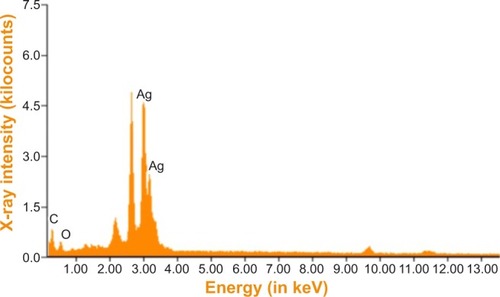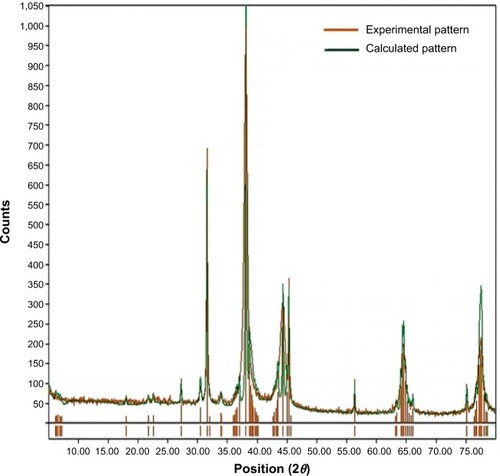Abstract
Background
Gymnema sylvestre is an ethno-pharmacologically important medicinal plant used in many polyherbal formulations for its potential health benefits. Silver nanoparticles (SNPs) were biofunctionalized using aqueous leaf extracts of G. sylvestre. The anticancer properties of the bioactive compounds and the biofunctionalized SNPs were compared using the HT29 human adenoma colon cancer cell line.
Methods
The preliminary phytochemical screening for bioactive compounds from aqueous extracts revealed the presence of alkaloids, triterpenes, flavonoids, steroids, and saponins. Biofunctionalized SNPs were synthesized using silver nitrate and characterized by ultraviolet–visible spectroscopy, scanning electron microscopy, energy-dispersive X-ray analysis, Fourier transform infrared spectroscopy, and X-ray diffraction for size and shape. The characterized biofunctionalized G. sylvestre were tested for its in vitro anticancer activity against HT29 human colon adenocarcinoma cells.
Results
The biofunctionlized G. sylvestre SNPs showed the surface plasmon resonance band at 430 nm. The scanning electron microscopy images showed the presence of spherical nanoparticles of various sizes, which were further determined using the Scherrer equation. In vitro cytotoxic activity of the biofunctionalized green-synthesized SNPs (GSNPs) indicated that the sensitivity of HT29 human colon adenocarcinoma cells for cytotoxic drugs is higher than that of Vero cell line for the same cytotoxic agents and also higher than the bioactive compound of the aqueous extract.
Conclusion
Our results show that the anticancer properties of the bioactive compounds of G. sylvestre can be enhanced through biofunctionalizing the SNPs using the bioactive compounds present in the plant extract without compromising their medicinal properties.
Introduction
For treatment of various diseases, bioactive components from medicinal plants that are similar to chemical compounds are used.Citation1 In recent years, the use of ethno-botanical information in medicinal plant research has gained considerable attention in some segments of the scientific community.Citation2 In one of the ethno-botanical surveys of medicinal plants commonly used by the Kani tribals in Tirunelveli hills of the Western Ghats in Tamil Nadu, India, it was revealed that Gymneme sylvestre is the most important species based on its use.Citation2 The use of plant parts and isolated phytochemicals for the prevention and treatment of various health ailments has been in practice for many decades.Citation3
G. sylvestre R. Br, commonly known as “Meshasringi”, is distributed over most of India and has a reputation in traditional medicine as a stomachic, diuretic, and a remedy to control diabetes mellitus. G. sylvestre R. BrCitation4 is a woody, climbing plant that grows in the tropical forests of Central and Southern India and in parts of Asia.Citation5 It is a pubescent shrub with young stems and branches, and has a distichous phyllotactic opposite arrangement pattern of leaves which are 2.5–6 cm long and are usually ovate or elliptical. The flowers are small, yellow, and in umbellate cymes, and the follicles are terete, lanceolate, and up to 3 inches in length.Citation6
In homeopathy, as well as in folk and ayurvedic medicine, G. sylvestre has been used for diabetes treatment.Citation7 G. sylvestre has bioactive components that can cure asthma, eye ailments, snakebite, piles, chronic cough, breathing troubles, colic pain, cardiopathy, constipation, dyspepsia, hemorrhoids, and hepatosplenomegaly, as well as assist in family planning.Citation8 In addition, it also possesses antimicrobial,Citation9 antitumor,Citation5 anti-obesity,Citation10 anti-inflammatory,Citation11 anti-hyperglycemic,Citation12 antiulcer, anti-stress, and antiallergic activity.Citation13
The presence of flavonoids, saponins, anthraquinones, quercitol, and other alkaloid have been reported in the flowers, leaves, and fruits of G. sylvestre.Citation14 The presence of other therapeutic agents, such as gymnemagenin, gymnemic acids, gymnemanol, and β-amyrin-related glycosides, which play a key role in therapeutic applications, have also been reported. The focus of the present work is to assess the potential therapeutic medicinal value of this herb and to understand/enhance the mechanistic action of their bioactive components.Citation14
G. sylvestre contains triterpenes, saponins, and gymnemic acids belonging to the oleane and dammarene classes.Citation15,Citation16 The plant extract has also tested positive for alkaloids, acidic glycosides, and anthraquinone derivatives. Oleanane saponins are gymnemic acids and gymnema saponins, while dammarene saponins are gymnemasides.
As reported by Thakur et alCitation14 the aqueous extracts of the G. sylvestre leaves showed the presence of gymnemic acids Ι–VΙ, while the saponin fraction of the leaves tested positive for the presence of gymnemic acids XV–XVIII. The gymnemic acid derivative of gymnemagenin was elucidated from the fraction VIII–XII, which is responsible for the antidiabetic activity, and the fraction VIII stimulates the pancreas for insulin secretion. The novel D-glucoside structure with anti-sweet principle is present in the I–V saponin fraction. The presence of pentatriacontane, α- and β-chlorophylls, phytin, resins, D-quercitol, tartaric acid, formic acid, butyric acid, lupeol, and stigmasterol has been reported as other plant constituents of G. sylvestre,Citation14 while the extract has also been tested positive for alkaloids.Citation13,Citation17
Sharma et al have reported the antioxidant activity of oleane saponins from G. sylvestre plant extract and determined the IC50 values for 2,2-diphenylpicrylhydrazyl (DPPH) scavenging, superoxide radical scavenging, inhibition of in vitro lipid peroxidation, and protein carbonyl formation as 238 μg/mL, 140 μg/mL, 99 μg/mL, and 28 μg/mL, respectively, which may be due to the presence of flavonoids, phenols, tannins, and triterpenoids.Citation18 The enhanced radiation (8 Gy)-induced augmentation of lipid peroxidation and depletion of glutathione and protein in mouse brain were reported by Sharma et alCitation18 using multiherbal ayurvedic formulations containing extracts of G. sylvestre, such as “Hyponidd” and “Dihar”. They also demonstrated the antioxidant activity by increasing the levels of superoxide dismutase, glutathione, and catalase in rats through in vivo studies.Citation19
Kang et alCitation20 proved the role of antioxidants from G. sylvestre in diabetic rats using ethanolic extracts. Using several antioxidant assays, eg, thiobarbituric acid assay with slight modifications, egg yolk lecithin or 2-deoxyribose (associated with lipid peroxidation) assay, superoxide dismutase-like activity assay, and 2,2′-azinobis (3-ethylbenzothiazoline-6-sulfonic acid) assay.
The potent anticancer activity of G. sylvestre against the human lung adenocarcinoma cell lines (A549) and human breast carcinoma cell lines (MCF7) using alcoholic extracts of the herb has been reported by Srikant et al.Citation21 Also, Amaki et alCitation22 reported the inhibition of the breast cancer resistance protein using the alcoholic extract of G. sylvestre.
Many plant-derived saponins, eg, ginsenosides, soyasaponins, and saikosaponins, have been found to exhibit significant anticancer activity. The anticancer activity of gymnemagenol on HeLa cancer cell lines in in vitro conditions was determined by the MTT cell proliferation assay for cytotoxic activity of saponins. Using 5 μg/mL, 15 μg/mL, 25 μg/mL, and 50 μg/mL concentrations of gymnemagenol, the IC50 value was found to be 37 μg/mL after 96 hours. The isolated bioactive constituent, gymnemagenol, showed a high degree of inhibition to HeLa cancer cell line proliferation, and saponins were not found to be toxic to the growth of normal cells under in vitro conditions.Citation23
Already many researchers have reported that the leaves of G. sylvestre lower blood sugar, stimulate the heart, uterus, and circulatory systems, and exhibit anti-sweet and hepatoprotective activities.Citation20,Citation24–Citation31 Administration of G. sylvestre extract to diabetic rats increased superoxide dismutase activity and decreased lipid peroxide by either directly scavenging the reactive oxygen species, due to the presence of various antioxidant compounds, or by increasing the synthesis of antioxidant molecules (albumin and uric acid).Citation24,Citation30,Citation32
Therefore, in this study, an attempt was made to synthesize the silver nanoparticles (SNPs) from aqueous extracts of the G. sylvestre leaves. These green-synthesized SNPs (GSNPs) of G. sylvestre were examined by ultraviolet–visible (UV–vis) spectroscopy, scanning electron microscopy (SEM), energy dispersive X-ray analysis (EDAX), Fourier transform infrared spectroscopy (FTIR), and X-ray diffraction (XRD) analysis for studying their size and shape. The synthesized and well-characterized nanoparticles (NPs) were tested for their cytotoxicity effect. Our findings clearly demonstrate that it is indeed possible to have a much greener way to synthesize SNPs without compromising their antibacterial properties and thus plant extracts may prove to be a good alternative to obtain such NPs with improved antibacterial and antiviral properties for diabetic wound healing applications. Goix et alCitation33 and Boholm and ArvidssonCitation34 have pointed out that silver is either beneficial or harmful in relation to four main values: the environment, health, sewage treatment, and product effectiveness. As reported by Barua et alCitation35 poly(ethylene glycol)-stabilized colloidal SNPs showed the nonhazardous anticancer and antibacterial properties. Jin et alCitation36 have reported the therapeutic applications of plant-extract-based scaffolds for wound healing and skin reconstitution studies.
Materials and methods
Collection of plants
Fresh leaves of G. sylvestre from plants of same age group of a single population were collected from the experimental Herbal Garden, Tamil University, Thanjavur, Tamil Nadu, India, in July, 2010. The herbarium was prepared for authentication (Ref No: SRM\CENR\PTC\2010\03), and taxonomic identification was done by Dr Jayaraman, Professor, Department of Botany, Madras Christian College, Tambaram, Chennai, Tamil Nadu. The herb sample is maintained in the research laboratory for further reference.
Preparation of aqueous extract
The leaves of G. sylvestre were washed with distilled water to remove the dirt and further washed with mild soap solution and rinsed thrice with distilled water. The leaves were blot-dried with tissue paper and shade dried at room temperature for 2 weeks. After complete drying, the leaves were cut into small pieces and powdered in a mixer and sieved using a 20-μm mesh sieve to get a uniform size range for further studies. Twenty grams of the sieved leaf powder was added to 100 mL of sterile distilled water in a 500-mL Erlenmeyer flask and boiled for 5 minutes. The flask was kept under continuous dark conditions at 30°C in a shaker. The extract was filtered and stored in an airtight container and protected from sunlight for further use.Citation37
Qualitative and quantitative phytochemical analysis
The qualitative phytochemical analysis of G. sylvestre extracts were performed following the methods of Parekh and ChandaCitation38 to determine the presence of alkaloids (Mayer, Wagner, Dragendorff), flavonoids (alkaline reagent, Shinoda), phenolics (lead acetate, alkaline reagent test), triterpenes (Liberman-Burchard test), saponins (foam test), and tannins (gelatin).Citation39 The results were qualitatively expressed as positive (+) or negative (−).Citation40 The chemicals used for the study were purchased from Sigma-Aldrich (Chennai, India).
Phytochemical quantitative analyses are described briefly in our previous paper.Citation13 The total phenolic content was measured using the Folin–Ciocalteu colorimetric method. The flavonoids were estimated using aluminum chloride colorimetric method. Gallic acid was used as standard for the analysis of total antioxidant capacity, and the DPPH radical scavenging activity was done following the methods described by Blios.Citation41
Synthesis of SNPs
Silver nitrate (AgNO3) was purchased from Sigma-Aldrich (St Louis, MO, USA), and all solutions were freshly made for the synthesis of SNPs. The aqueous leaf extract of G. sylvestre was used for the bioreduction synthesis of the NPs. The SNPs were synthesized by adding 5 mL of plant extract to 15 mL of 1 mM aqueous AgNO3 solution in a 250-mL Erlenmeyer flask and incubated in a rotary shaker at 150 rpm in dark. The synthesis of NPs was confirmed spectrophotometrically at every 30-minute interval till no reduction was observed. The reduction was observed by the color change in the colloidal solution, which confirmed the formation of SNPs.Citation42,Citation43
Characterization of SNPs
The GSNPs were characterized periodically by measuring the bioreduction of AgNO3 using a UV–vis 3000+ double-beam spectrophotometer (Lab India, Maharashtra, India). The spectrometric range was 200–800 nm, and scanning interval was 0.5 nm.
The surface morphology of the biofunctionalized SNPs was characterized by high-resolution SEM analysis (JSM-5600LV; JEOL, Tokyo, Japan) and the elemental compositions were determined by EDAX analysis (S-3400N; Hitachi, Tokyo, Japan). The functional characterization of biomolecules present in the GSNPs from the leaf extract of G. sylvestre was done by FTIR spectrometry (RX1; Perkin-Elmer, Waltham, MA, USA).Citation44
The crystal lattice and the size of the synthesized NPs were determined by XRD measurements using an XRD-6000 X-ray diffractometer (Shimadzu, Kyoto, Japan). The crystal-lite domain size was calculated from the width of the XRD peaks, as described in our previous papers.Citation17,Citation45–Citation47
In vitro anticancer activity
Cell line and culture medium
Vero cell line (derived from the normal kidney of adult monkeys) and human adenocarcinoma colon HT29 cells were purchased from the National Center for Cell Sciences, Pune, India. The cells were cultured under standard conditions in Dulbecco’s Modified Eagle Medium (DMEM), supplemented with 10% heat-inactivated fetal bovine serum (FBS), 100 U/mL of penicillin, and 100 U/mL of streptomycin in a humidified incubator set at 37°C with 5% CO2.Citation17
Cell viability by MTT assay
MTT assay was performed to determine the cytotoxic properties of biofunctionalized SNPs against HT29 cell lines by adding 1×105 cells/well in 12-well plates and incubated with various concentrations of biofunctionalized particles (83 μg/mL, 84 μg/mL, and 85 μg/mL). Vero cells were used as a monolayer for culturing the HT29 cells. The cell lines were seeded in 96-well tissue culture plates and the appropriate concentrations of GSNP stock solutions were added to the cultures to obtain the respective concentration of the NPs and incubated for 48 hours at 37°C. The untreated cells were used as control. The incubated cultured cells were subjected to MTT colorimetric assay. All assays were performed in triplicate, and the aqueous leaf extract of the G. sylvestre were also similarly assayed for the anticancer activity for comparison.Citation17,Citation48
Morphological changes
The cytotoxicity effects were observed using an inverted microscope, and the morphological changes were photographed.Citation49
Results
Phytochemical screening of G. sylvestre leaf extract
The preliminary phytochemical screening of aqueous extracts of G. sylvestre revealed the presence of alkaloids, phenols, flavonoids, sterols, tannins, and triterpenes (). As shown in , 125.62±26.84 μg/g of total flavonoids, 285.23±1.11 μg/g of total phenols, and 111.53±15.13 μg/g of tannin were present in the aqueous extract of G. sylvestre. The flavonoids and phenolic compounds exhibited a wide range of biological activities, such as antioxidant and lipid peroxidation inhibition.Citation13
Table 1 Phytochemical screening of leaf extract of Gymnema sylvestre
Table 2 Estimation of phytochemical compounds of leaf extract of Gymnema sylvestre
The estimated total antioxidant activity was 9.13±0.04 μg/g and the DPPH radical scavenging activity was 52.14%±0.32% ().
Characterization of biofunctionalized SNPs
The color change observed in the aqueous silver nitrate solution showed that the SNPs were formed rapidly within 30 minutes of incubation of the plant extract with aqueous AgNO3 solution. The colorless solution changed to ruby red, confirming the formation of SNPs (). The intensity of the red color increased with time because of the excited surface plasmon resonance effect and reduced AgNO3. The control aqueous AgNO3 solution (without leaf extract) showed no change of color with time and was taken as the blank reference.
Figure 1 Surface plasmon resonance of silver nanoparticles.
Notes: (A) silver nitrate solution; (B) green-synthesized silver nanoparticles in ruby red color after 30 minutes.

UV–vis spectrometry is a reliable and reproducible technique that can be used to accurately characterize the metal NPs though it does not provide direct information regarding the particle sizes. The surface plasmon bands (absorbance spectra) are influenced by the size and shape of the NPs produced, along with the dielectric constant of the surrounding media.
shows the time-dependent intensity of the absorption band, which reached its maximum peak at 12 hours, after which no further change in the spectrum was observed indicating that the precursors had been consumed. Initially, the UV–vis spectrum did not show evidence of any absorption in the region 350–600 nm, but after the addition of extract a distinct band was observed at 432 nm.
Figure 2 Time-dependent absorption spectra of silver nanoparticles after the bioreduction of silver in the aqueous extract of Gymnema sylvestre.
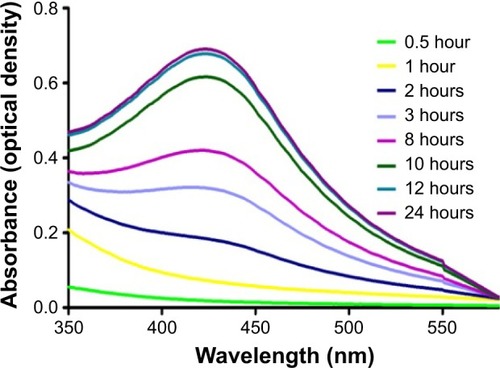
When silver nitrate was added to the aqueous plant extract of G. sylvestre, it was reduced to SNPs by the aldehyde group present in the flavonoids (125.6 μg/g), which was further oxidized to the carboxyl group. Also, the carboxyl groups of the phenols from the G. sylvestre extract (285.23 μg/g) acted as a surfactant to attach the major phytochemicals from the plant extract to the surface of the SNPs. Our previous study on the synthesis of SNPs using aqueous extracts of Memecylon edule,Citation37 Memecylon umbellatum,Citation47 Chrysopogon zizanioidesCitation46 and Indigofera aspalathoidesCitation50 showed that the color of the reaction mixture during the formation of GSNPs changed to ruby red color from colorless/straw color. Our results are also comparable with the other available reports for plant-extract-mediated synthesis of SNPs.
From , it is clear that the synthesized SNPs were approximately spherical and of different sizes. The SEM images in the figure clearly indicated a thin layer of phytochemicals from the plant extract covering the synthesized SNPs. Mostly the total phenolic content, flavonoids, and tannins were responsible for the bioreduction of the SNPs. In this green synthesis, the phytochemicals from the plant extract acted as a surfactant to prevent the aggregation of the synthesized SNPs. The SEM images of our earlier research had revealed that this biologically eco-friendly synthesis of NPs utilizing the leaf extracts of M. edule,Citation37 C. zizanioides,Citation46 and M. umbellatumCitation47 showed no aggregation due to the biomolecules from the plant extract. And the mechanism behind this particle formation with no aggregation may be the spontaneous nucleation and isotropic growth of NPs along with the plant extract. As these chains grow in diameter with increasing silver deposition, spherical particles break off from these structures forming nanospherical particles which can be typically observed from this synthesis.Citation51
Figure 3 Scanning electron microscopic image of green silver nanoparticles synthesized by reduction of aqueous AgNO3 ions using aqueous extract of Gymnema sylvestre.
Abbreviations: HV, high voltage; WD, working distance; mag, magnification; ETD, Everhart–Thornley detector.

The elemental composition of green-synthesized AgNPs was analyzed through EDAX. These measurements confirmed the presence of the elementary silver signal of the SNPs. The vertical axis displays the number of X-ray counts and the horizontal axis displays the energy in keV.
The EDAX spectrum of the biofunctionalized SNPs in clearly shows the strong signals from silver atoms along with the weaker signals from carbon and oxygen present from biomolecules of the plant extract. The elemental silver peak at 2–4 keV, which is the major emission peak specified for metallic silver, with minor peaks of C and O were also seen due to the capping of Ag NPs by the biomolecules of G. sylvestre leaf extract, and the absence of other peaks evidenced the purity of the Ag NPs.
FTIR analysis in shows that the SNPs produced by G. sylvestre extract were coated by phytocompounds and secondary metabolites such as saponins, terpenoids, and gymnemagenin derivative of gymnemic acid containing the functional groups of amines, aldehydes, carboxylic acids, and alcohols.
Figure 5 Fourier transform infrared spectroscopy spectrum of green-synthesized silver nanoparticles along with the plant extract of Gymnema sylvestre (GS).
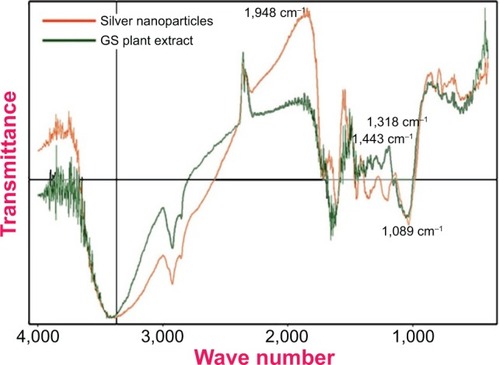
The presence of the amide linkages seen in suggests that the different functional groups of the proteins present in the plant extracts might be capping the NPs and playing an important role in the stabilization of the green NPs formed. The band at 1,443 cm−1 was assigned to the methylene scissoring vibrations of proteins, and the bands located at 1,318 cm−1 and 1,089 cm−1 are due to the C–N stretching vibration of aromatic and aliphatic amines, respectively, which agrees with earlier reports of Suman et al.Citation52
The positions of these bands were comparable to those reported for phytochemicals reported in the G. sylvestre extract as total phenols, flavonoids, and tannins (). Thus, we can confirm that the nanocapping of the phytochemicals from the G. sylvestre extract is responsible for the reduction and subsequent stabilization of the SNPs. The absorption bands that appear in the IR spectrum of the aqueous extract could also be seen in the IR spectra of phyto-capped Ag NPs, confirming the role of the phyto constituents (mostly gymnemic acid) in protecting the Ag NPs from aggregation.
Also, during our repeated experiments there were no batch-to-batch variations in size, regardless of the isotopic composition, and the particles diameters of the SNPs formed were known to a high degree of accuracy. A detailed study on the large-scale synthesis and elemental composition on the synthesized NPs can be carried out using inductively coupled plasma mass spectrometry to obtain reproducible compositions in every batch. In future, the elemental analysis can be carried out as described earlier by other researchers.Citation53,Citation54
XRD analysis of NPs represented in shows several size-dependent features leading to irregular peak position, height, and width. XRD was mainly carried out to study the crystalline nature of the green-synthesized G. sylvestre SNPs. From the figure, the GSNPs are seen to exhibit monocrystallinity. The XRD peaks at 38.2°, 44.5°, 64.7°, and 77.7° can be indexed to the [111], [200], [220], and [311] planes, indicating that the SNPs are highly crystalline. Similar results were reported for Abelmoschus esculentus, Citrus limon, Citrus reticulate, and Citrus sinensisCitation55,Citation56 and in our previous studies using C. zizanioides.Citation46
shows the characteristic features of the GSNPs using various plant parts of different plant species reported by various researchers along with our previous reports.
Table 3 Comparative chart of the characterization of green-synthesized silver nanoparticles using various plant extracts
In vitro anticancer activity
From , it can be observed that, as the concentration of the GSNPs increased, the percentage of viable cells decreased in the cytotoxicity studies by MTT assay. The GSNPs were taken up by mammalian cells through different mechanisms such as pinocytosis, endocytosis, and phagocytosis.Citation75 Once the NPs enter the cells, they interact with the cellular materials and cause DNA damage and cell death.
Figure 7 Anticancer activity of the green-synthesized silver nanoparticles.
Abbreviation: GS, Gymnema sylvestre.
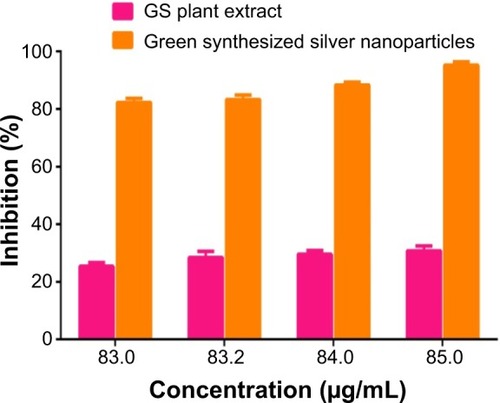
The GSNPs at 85 μg/mL concentration showed 95.23% inhibition of HT29 cell growth. The concentration of the NPs was chosen based on the TC ID50 value (results not shown). Another promising result was that G. sylvestre plant extracts alone at 85 μg/mL concentration showed 30.77% inhibition of HT29 cell lines growth. From our results, it can be concluded that the GSNPs could have induced intracellular reactive oxygen species generation, which can be evaluated using intracellular peroxide-dependent oxidation, and caused cell death. The control cells were clustered, healthy, and viable cells (), whereas the HT29 cells’ proliferation was significantly inhibited by GS (). The SNP-treated cells showed increased apoptotic morphological changes (), also the clearly visible cell debris in is due to cell death by 85 μg/mL SNP treatment.
Figure 8 Inverted microscopic image of HT29 (A) control cells, (B) Gymnema sylvestre-treated (85 μg/mL), (C) silver nanoparticle-treated (83 μg/mL), and (D) silver nanoparticle-treated (85 μg/mL) cells.
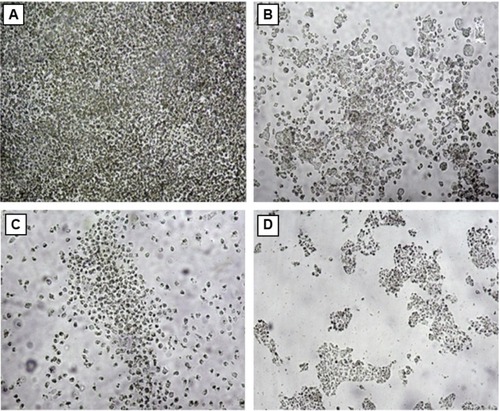
These results indicate that the sensitivity of HT29 human colon cancer cell line for cytotoxic drugs is higher than that of the Vero cell line for the same cytotoxic agents. Sahu et alCitation76 have reported the presence of four new tritepenoid saponins, namely gymnemasins A, B, C, and D, from the leaves of G. sylvestre, while Chan has identified the presence of acylation with diangeloyl groups at the C21–22 positions in triterpenoid saponins, which is essential for cytotoxcity toward tumor cells.Citation77 Tang et alCitation78 have reported that saponin could induce apoptosis of U251 cells, and both BAD-mediated intrinsic apoptotic signaling pathway and caspase-8-mediated extrinsic apoptotic signaling pathway were involved in the apoptosis.
The promising saponins were further studied as potential anticancer agents by many researchers. Ai et alCitation79 proposed a qualitative method that can be used to recognize the presence or absence of cancer cells with gold NPs for targeted cancer cell imaging and efficient photodynamic therapy. As reported by Raghavendra et alCitation80 the size effects and multifunctionality are the main characteristics of NPs, so our method of one-step synthesis of SNPs using the aqueous extract of G. sylvestre may serve as a potential anticancer drug for cancer therapy. Further studies have to be carried out to understand the nature of cytotoxicity and the death or proliferation of cells caused by GSNPs from G. sylvestre leaf extract.
Conclusion
The green synthesis of biofunctionalized SNPs from the leaves of G. sylvestre was economical, nontoxic, and environmentally benign. Due to the reducing and capping nature of the bioactive phytocompounds present in the aqueous extract of G. sylvestre, a cap was formed around the silver ions of the biofunctionalized SNPs which were stable. The presence of the functional group of the bioactive compounds was confirmed by FTIR spectra. The particle size and the spherical shape of the SNPs were determined by XRD and SEM analyses. Since the plant extract and the biofunctionalized SNPs showed anticancer activity against cancer cells, G. sylvestre may serve as a source for potential anticancer drugs. The present study showed the anticancer activities of both the bioactive compounds of the leaf extract and the biofunctionalized SNPs synthesized against HT29 human adenocarcinoma cells in vitro. Our studies provide an important basis for the application of NPs for in vitro anticancer activity against human colon adenocarcinoma cells. Our earlier reports have also shown the potential antiulcer properties of G. sylvestre in mice.Citation13 So GSS is a good plant candidate for further studies in alternative medicine due its multifunctional medical properties
Acknowledgments
The authors gratefully acknowledge the management, SRM University, for providing the facilities and supporting the work.
Disclosure
The authors declare no conflicts of interest in this work.
References
- GroverJKYadavSVatsVMedicinal plants of India with anti-diabetic potentialJ Ethnopharmacol20028118110012020931
- AyyanarMIgnacimuthuSEthnobotanical survey of medicinal plants commonly used by Kani tribals in Tirunelveli hills of Western Ghats, IndiaJ Ethnopharmacol2011134385186421291981
- PedersenMEVestergaardHTHansenSLBahSDialloDJägerAKPharmacological screening of Malian medicinal plants used against epilepsy and convulsionsJ Ethnopharmacol2009121347247519056478
- KarthicRNagarajSArulmuruganPSeshadriSRengasamyRKathiravanKGymnema sylvestre R. Br. suspension cell extract show antidiabetic potential in Alloxan induced diabetic albino male ratsAsian Pac J Trop Biomed201222S930S933
- WuXMaoGFanQIsolation, purification, immunological and anti-tumor activities of polysaccharides from Gymnema sylvestreFood Res Int2012482935939
- KanetkarPSinghalRKamatMGymnema sylvestre: a memoirJ Clin Biochem Nat200741September7781
- ChattopadhyayRRPossible mechanism of antihyperglycemic effect of Gymnema sylvestre leaf extract, part IGen Pharmacol19983134954969703226
- PatelKGadewarMTripathiRPharmacological and analytical aspects of gymnemic acid: a concise reportAsian Pac J Trop Dis201225414416
- SatdiveRKAbhilashPFulzeleDPAntimicrobial activity of Gymnema sylvestre leaf extractFitoterapia2003747–869970114630178
- PreussHGBagchiDBagchiMRaoCVSDeyDKSatyanarayanaSEffects of a natural extract of (-)-hydroxycitric acid (HCA-SX) and a combination of HCA-SX plus niacin-bound chromium and Gymnema sylvestre extract on weight lossDiabetes Obes Metab20046317118015056124
- ManviFMalikJAlagawadiKNoolviMEvaluation of anti-inflammatory activity of Gymnema sylvestre leaves extract in ratsInt J Green Pharm200822114115
- YadavMLavaniaATomarRPrasadGBKSJainSYadavHComplementary and comparative study on hypoglycemic and antihyperglycemic activity of various extracts of Eugenia jambolana seed, Momordica charantia fruits, Gymnema sylvestre, and Trigonella foenum graecum seeds in ratsAppl Biochem Biotechnol201016082388240019904502
- ArunLBArunachalamAMArunachalamKDAnnamalaiSKAmit KumarKIn vivo anti-ulcer, anti-stress, anti-allergic, and functional properties of Gymnemic acid isolated from Gymnema sylvestre R BrBMC Complement Altern Med20141417024559073
- ThakurGSSharmaRSanodiyaBSPandeyMPrasadGBisenPSGymnema sylvestre: an alternative therapeutic agent for management of diabetesJ Appl Pharm Sci201221216
- ManniPESinsheimerJEConstituents from Gymnema sylvestre leavesJ Pharm Sci19655410154115445883239
- NakamuraYTsumuraYTonogaiYShibataTFecal steroid excretion is increased in rats by oral administration of gymnemic acids contained in Gymnema sylvestre leavesJ Nutr19991291214122210356090
- ArunachalamKDArunLBAnnamalaiSKArunachalamAMBiofunctionalized gold nanoparticles synthesis from Gymnema Sylvestre and its preliminary anticancer activityInt J Pharm Pharm Sci201464423430
- SharmaKSinghUVatsSPriyadarsiniKBhatiaAKamalREvaluation of evidenced-based radioprotective efficacy of Gymnema sylvestre leaves in mice brainJ Environ Pathol Toxicol Oncol200928431132320102328
- PatelSSShahRSGoyalRKAntihyperglycemic, antihyperlipidemic and antioxidant effects of Dihar, a polyherbal ayurvedic formulation in streptozotocin induced diabetic ratsIndian J Exp Biol200947756457019761040
- KangM-HLeeMSChoiM-KMinK-SShibamotoTHypoglycemic activity of Gymnema sylvestre extracts on oxidative stress and antioxidant status in diabetic ratsJ Agric Food Chem201260102517252422360666
- SrikanthAVMaricarSLakshmiMNRavi KumarPMadhava ReddyBAnticancer activity of Gymnema sylvestre R. BrInt J Pharm Sci Nanotechnol20103124
- AmakiHTAtohHSOriSHInhibitory effects of herbal extracts on breast cancer resistance protein (BCRP) and structure-inhibitory potency relationship of isoflavonoidsDrug Metab Pharmacokinet201025217017920460823
- KhannaVKannabiranKAnticancer-cytotoxic activity of saponins isolated from the leaves of gymnema sylvestre and eclipta prostrata on HeLa cellsInt J Green Pharm200933227229
- BaskaranKAhamathBKShanmugasundaramKRShanmugasundaramERBAntidiabetic effect of a leaf extract from Gymnema sylvestre in non-insulin-dependent diabetes mellitus patientsJ Ethnopharmacol19903032953052259217
- ShanmugasundaramERBRajeswariGBaskaranKKumarBRRShanmugasundaramKRAhmathBKUse of Gymnema sylvestre leaf extract in the control of blood glucose in insulin-dependent diabetes mellitusJ Ethnopharmacol19903032812942259216
- MeiselmanHLHalpernBPEffects of Gymnema sylvestre on complex tastes elicited by amino acids and sucrosePhysiol Behav1970512137913845524525
- AnanthanRLathaMRamkumarKMPariLBaskarCNarmatha BaiVModulatory effects of Gymnema montanum leaf extract on alloxan-induced oxidative stress in Wistar ratsNutrition200420328028514990269
- El ShafeyAAMEl-EzabiMMSeliemMMEOudaHHMIbrahimDSEffect of Gymnema sylvestre R. Br. leaves extract on certain physiological parameters of diabetic ratsJ King Saud Univ – Sci2013252135141
- LeachMJGymnema sylvestre for diabetes mellitus: a systematic reviewJ Altern Complement Med200713997798318047444
- RamkumarKMVanithaPUmaCSuganyaNBhakkiyalakshmiESujathaJAntidiabetic activity of alcoholic stem extract of Gymnema montanum in streptozotocin-induced diabetic ratsFood Chem Toxicol201149123390339421978819
- AhmedABRaoASRaoMVIn vitro callus and in vivo leaf extract of Gymnema sylvestre stimulate β-cells regeneration and anti-diabetic activity in Wistar ratsPhytomedicine201017131033103920537514
- MahdiAChandraASinghRShuklaSMishraLCAhmadSEffect of herbal hypoglycemic agents on oxidative stress and antioxidant status in diabetic ratsIndian J Clin Biochem200318281523105386
- GoixSLévêqueTXiongTTEnvironmental and health impacts of fine and ultrafine metallic particles: assessment of threat scoresEnviron Res2014133018519424959986
- BoholmMArvidssonRControversy over antibacterial silver: implications for environmental and sustainability assessmentsJ Clean Prod2014680135143
- BaruaSKonwarhRBhattacharyaSSNon-hazardous anticancerous and antibacterial colloidal “green” silver nanoparticlesColloids Surf B Biointerfaces20131050374223352940
- JinGPrabhakaranMPKaiDAnnamalaiSKArunachalamKDRamakrishnaSTissue engineered plant extracts as nanofibrous wound dressingBiomaterials201334372473423111334
- ElavazhaganTArunachalamKDMemecylon edule leaf extract mediated green synthesis of silver and gold nanoparticlesInt J Nanomedicine201161265127821753878
- ParekhJChandaSVIn vitro antimicrobial activity and phytochemical analysis of some Indian medicinal plantsTurk J Biotechnol2008315358
- ArunachalamKDSubhashiniSAnnamalaiSKWound healing and antigenotoxic activities of Aegle marmelos with relation to its antioxidant propertiesJ Pharm Res20125314921502
- GuruvaiahPArunachalamAVelanLPTEvaluation of phytochemical constituents and antioxidant activities of successive solvent extracts of leaves of Indigofera caerulea Roxb using various in vitro antioxidant assay systemsAsian Pac J Trop Dis20122S118S123
- CieślaŁKryszeńJStochmalAOleszekWWaksmundzka-HajnosMApproach to develop a standardized TLC-DPPH• test for assessing free radical scavenging properties of selected phenolic compoundsJ Pharm Biomed Anal20127012613522749343
- Von WhiteG2ndKerscherPBrownRMGreen synthesis of robust, biocompatible silver nanoparticles using garlic extractJ Nanomater20122012112
- ShameliKAhmadMBZamanianAGreen biosynthesis of silver nanoparticles using Curcuma longa tuber powderInt J Nanomedicine201275603561023341739
- DipankarCMuruganSThe green synthesis, characterization and evaluation of the biological activities of silver nanoparticles synthesized from Iresine herbstii leaf aqueous extractsColloids Surf B Biointerfaces20129811211922705935
- ArunachalamKDAnnamalaiSKArunachalamAMKennedySOne step green synthesis of phytochemicals mediated gold nanoparticles from Aegle marmales for the prevention of urinary catheter infectionInt J Pharm Pharm Sci201461700706
- ArunachalamKDAnnamalaiSKChrysopogon zizanioides aqueous extract mediated synthesis, characterization of crystalline silver and gold nanoparticles for biomedical applicationsInt J Nanomedicine201382375238423861583
- ArunachalamKDAnnamalaiSKHariSOne-step green synthesis and characterization of leaf extract-mediated biocompatible silver and gold nanoparticles from Memecylon umbellatumInt J Nanomedicine201381307131523569372
- VasanthKIlangoKMohankumarRAgrawalADubeyGPAnticancer activity of Moringa oleifera mediated silver nanoparticles on human cervical carcinoma cells by apoptosis inductionColloids Surf B Biointerfaces2014117C35435924681047
- MateosRPereira-CaroGBaconJRAnticancer activity of olive oil hydroxytyrosyl acetate in human adenocarcinoma caco-2 cellsJ Agric Food Chem201361133264326923452288
- ArunachalamKDAnnamalaiSKArunachalamAMKennedySGreen synthesis of crystalline silver nanoparticles using Indigofera aspalathoides-medicinal plant extract for wound healing applicationsAsian J Chem201325supplS311S314
- AkhtarMSPanwarJYunY-SBiogenic synthesis of metallic nanoparticles by plant extractsACS Sustain Chem Eng201316591602
- SumanTYRadhika RajasreeSRRamkumarRRajthilakCPerumalPThe green synthesis of gold nanoparticles using an aqueous root extract of Morinda citrifolia LSpectrochim Acta A Mol Biomol Spectrosc2014118111624036301
- KimSTKimHKHanSHJungECLeeSDetermination of size distribution of colloidal TiO2 nanoparticles using sedimentation field-flow fractionation combined with single particle mode of inductively coupled plasma-mass spectrometryMicrochem J2013110636642
- ArunachalamKDAnnamalaiSKBaskaranKVRajaramSJhaSKSreedeviSpatial and multivariate analysis of trace elements in the surface water and deep sediments of fresh water aquatic ecosystemAm J Environ Sci2014102102122
- JayaseelanCRamkumarRRahumanAAPerumalPGreen synthesis of gold nanoparticles using seed aqueous extract of Abelmoschus esculentus and its antifungal activityInd Crops Prod2013450423429
- SujithaMVKannanSGreen synthesis of gold nanoparticles using Citrus fruits (Citrus limon, Citrus reticulata and Citrus sinensis) aqueous extract and its characterizationSpectrochim Acta A Mol Biomol Spectrosc20131020152323211617
- LooYYChiengBWNishibuchiMRaduSSynthesis of silver nanoparticles by using tea leaf extract from Camellia sinensisInt J Nanomedicine201274263426722904632
- GhoshSPatilSAhireMSynthesis of silver nanoparticles using Dioscorea bulbifera tuber extract and evaluation of its synergistic potential in combination with antimicrobial agentsInt J Nanomedicine2012748349622334779
- KhanMKhanMAdilSFGreen synthesis of silver nanoparticles mediated by Pulicaria glutinosa extractInt J Nanomedicine201381507151623620666
- ShameliKAhmadMBZamanianAGreen biosynthesis of silver nanoparticles using Curcuma longa tuber powderInt J Nanomedicine201275603561023341739
- HeYDuZLvHGreen synthesis of silver nanoparticles by Chrysanthemum morifolium Ramat. extract and their application in clinical ultrasound gelInt J Nanomedicine201381809181523687447
- PasupuletiVRPrasadShiekhRABiogenic silver nanoparticles using Rhinacanthus nasutus leaf extract: synthesis, spectral analysis, and antimicrobial studiesInt J Nanomedicine201383355336424039419
- ArokiyarajSArasuMVVincentSRapid green synthesis of silver nanoparticles from Chrysanthemum indicum L and its antibacterial and cytotoxic effects: an in vitro studyInt J Nanomedicine2014937938824426782
- RamamurthyCHPadmaMsamadanamIDThe extra cellular synthesis of gold and silver nanoparticles and their free radical scavenging and antibacterial propertiesColloids Surf B Biointerfaces201310280881523107960
- PrabhuDArulvasuCBabuGManikandanRSrinivasanPBiologically synthesized green silver nanoparticles from leaf extract of Vitex negundo L. induce growth-inhibitory effect on human colon cancer cell line HCT15Process Biochem2013482317324
- ZhangYChengXZhangYXueXFuYBiosynthesis of silver nanoparticles at room temperature using aqueous aloe leaf extract and antibacterial propertiesColloids Surf A Physicochem Eng Aspects20134236368
- KaruppiahMRajmohanRGreen synthesis of silver nanoparticles using Ixora coccinea leaves extractMater Lett201397141143
- NazeruddinGMPrasadNRPrasadSRGaradkarKMNayakAKIn-vitro bio-fabrication of silver nanoparticle using Adhathoda vasica leaf extract and its anti-microbial activityPhys E Low-Dimens Syst Nanostruct2014615661
- Vijay KumarPPNPammiSVNKolluPSatyanarayanaKVVShameemUGreen synthesis and characterization of silver nanoparticles using Boerhaavia diffusa plant extract and their anti bacterial activityInd Crops Prod201452562566
- RajaKSaravanakumarAVijayakumarREfficient synthesis of silver nanoparticles from Prosopis juliflora leaf extract and its antimicrobial activity using sewageSpectrochim Acta A Mol Biomol Spectrosc20129749049422835939
- PonarulselvamSPanneerselvamCMuruganKAarthiNKalimuthuKThangamaniSSynthesis of silver nanoparticles using leaves of Catharanthus roseus Linn. G. Don and their antiplasmodial activitiesAsian Pac J Trop Biomed20122757458023569974
- SumanTYRadhika RajasreeSRKanchanaAElizabethSBBiosynthesis, characterization and cytotoxic effect of plant mediated silver nanoparticles using Morinda citrifolia root extractColloids Surf B Biointerfaces2013106747823434694
- VijayakumarMPriyaKNancyFTNoorlidahAAhmedABABiosynthesis, characterisation and anti-bacterial effect of plant-mediated silver nanoparticles using Artemisia nilagiricaInd Crops Prod201341235240
- MeenakumariSArunachalamKDAnnamalaiSKScreening and characterisation of silver nanoparticles for the prevention of biofilm in urinary cathetersAsian J Chem201325supplS347S349
- KruszewskiMGrądzkaIBartłomiejczykTOxidative DNA damage corresponds to the long term survival of human cells treated with silver nanoparticlesToxicol Lett2013219215115923518319
- SahuNPMahatoSBSarkarSKPoddarGTriterpenoid saponins from Gymnema sylvestrePhytochemistry1996414118111858728717
- ChanP-KAcylation with diangeloyl groups at C21–22 positions in triterpenoid saponins is essential for cytotoxcity towards tumor cellsBiochem Pharmacol200773334135017092489
- TangHFLinHWChenXLChengGZhaoYPWenADCytotoxic triterpenoid saponins from Ardisia pusillaChinese Chem Lett2009202193196
- AiJXuYLouBLiDWangEMultifunctional AS1411-functionalized fluorescent gold nanoparticles for targeted cancer cell imaging and efficient photodynamic therapyTalanta20141180546024274270
- RaghavendraRArunachalamKAnnamalaiSKArunachalamAMDiagnostics and therapeutic application of Gold nanoparticlesInt J Pharm Pharm Sci20146suppl 27487

